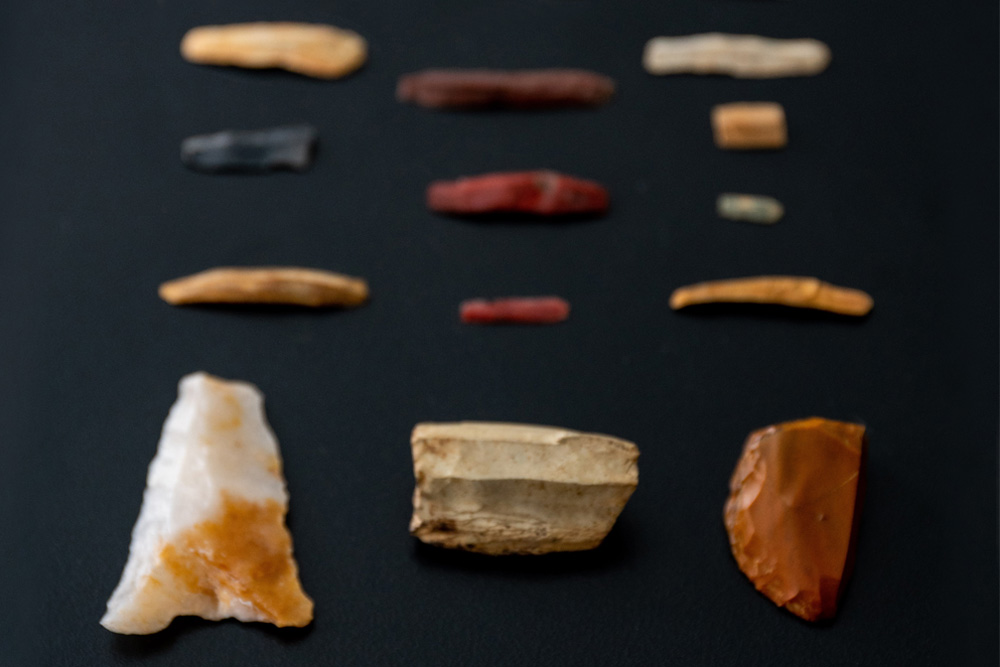Brian Wygal, Ph.D., an associate professor of anthropology at Adelphi, believes that light can be shed on the colonization of Alaska by prehistoric people through the study of microblades.

Much of the detail surrounding the colonization of Alaska by prehistoric people who migrated from Siberia is shrouded in mystery.
Brian Wygal, Ph.D., an associate professor of anthropology at Adelphi, believes that light can be shed on the subject through the study of microblades, small but relatively advanced stone tools fashioned by the first Americans.
In February of this year, Dr. Wygal published the results of his research on the prehistoric implements in the journal Quaternary International. The publication followed his discovery of an object that dwarfs these stone implements in size—the 14,200-year-old tusk of what may have been the last woolly mammoth in Alaska. That find, which he and Adelphi Assistant Professor Kathryn Krasinski, Ph.D., made while on a dig with students in 2016, attracted worldwide attention.
Both Dr. Wygal’s find and his microblade research may help settle the long-standing debate among archaeologists about the most puzzling gap in the chronology of human history—the timing of the colonization and the peopling of North America.
Migrants from northeast Asia reached Alaska, which anthropologists refer to as eastern Beringia, at the end of the last Ice Age. “No one knows what prompted their migration, but the Upper Paleolithic cultures were highly mobile and often moved around in search of game, especially woolly mammoths,” Dr. Wygal said. “As these mammals became increasingly rare in the Old World,  the first Americans may have followed them into Alaska via a land bridge connecting Alaska with northeast Asia.”
the first Americans may have followed them into Alaska via a land bridge connecting Alaska with northeast Asia.”
Dr. Wygal subscribes to a “standstill model” of colonization, which contends that these early migrants remained somewhere in Beringia for many generations before beginning to move south as the ice receded roughly 14,000 years ago. Scholars have never come to a consensus on the migration’s historical time scale, however. “This ‘standstill model’ makes sense given the complexities of tool kit variability in the area,” he explained. “Yet Alaska archaeologists continue to disagree on a unified culture history.”
Scholarly dispute revolves around the presence or absence of microblades, tools crafted by the prehistoric colonizers in Alaska’s artifact-rich Nenana and Denali complexes during the Ice Age. Since complexes, or clusters of interrelated artifacts and traits within a settlement, can represent its general archaeological culture, Dr. Wygal believes that correctly categorizing and classifying these ancient tools is a necessary first step in resolving this dispute and establishing a coherent chronology.
In his Quaternary International article, “The peopling of eastern Beringia and its archaeological complexities,” Dr. Wygal looked at where microblade technology was produced and used, and where it was absent, among Denali complex activities. He then compared how tool use varied between regions, ecozones and topographical elevation.
The prehistoric tools he analyzed are from the Pleistocene/ Holocene transition period. Largely supported by funding from Adelphi, he examined samples from 31 archaeological sites, only half of which contained tools with microblade technology. The use of Denali microblade technology, he found, varied by elevation.
“By focusing on Denali complex assemblages and comparing tool selection to elevation and ecozones, a small but significant pattern emerged,” Dr. Wygal said. Based on this study, he concluded that assemblages with the greatest artifact diversity, including microblades, should occur in the montane zone and near large lakes, with smaller cores in the lowlands. Additionally, he surmised that the widespread Denali complex differed from the more limited and isolated Nenana complex, based on the Denali complex’s wider variety of available tools, including microblades, that its users organized to survive in diverse habitats.
Uncertainty over whether the Nenana and Denali complexes were settled by different populations of migrants also complicates scholars’ grasp of the first Americans’ prehistoric colonization. “Do the Nenana and Denali complexes represent ethnically distinct people who made and used stone tools differently?” Dr. Wygal asked. “Or are they the result of normal artifact variability within a single technological system?” He believes there were separate phases in the initial peopling of Alaska. “Archaeological records show that there were two or even three different occupation events in the late Pleistocene era,” he said. “They all used different types of stone tools, which suggests they may have been left behind by different cultures.”
Dr. Wygal hopes that his explanation for tool kit variation in central Alaska will inspire further research that will resolve the classification debate over the initial colonization of eastern Beringia. “Understanding the complicated behaviors behind the successful colonization of eastern Beringia will ultimately reveal how and when the initial settlement of the Americas unfolded.”
Brian Wygal, Ph.D., is chiefly interested in Alaska archaeology, environmental archaeology, deglaciation and human colonization, human ecology, technological organization, and issues surrounding first Americans. Instrumental in the founding of the Adelphi Archaeological Field School in Alaska, he has led numerous digs with Adelphi students, resulting in important finds of prehistoric fossils, including a complete mammoth tusk.
For further information, please contact:
Todd Wilson
Strategic Communications Director
p – 516.237.8634
e – twilson@adelphi.edu